Computational Thinking
Anybody can learn. The Center for Connected Learning and Computer-Based Modeling. NetLogo. NetLogo is a multi-agent programmable modeling environment.

It is used by tens of thousands of students, teachers and researchers worldwide. It also powers HubNet participatory simulations. It is authored by Uri Wilensky and developed at the CCL. You can download it free of charge. What can you do with NetLogo? Join mailing lists here. Download NetLogo Go to NetLogo Web NetLogo comes with a large library of sample models.
K–12 Computational Learning - ACM. By Stephen Cooper, Lance C.
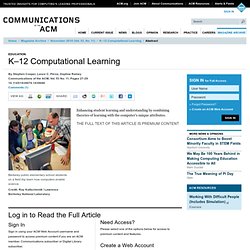
Pérez, Daphne Rainey Communications of the ACM, Vol. 53 No. 11, Pages 27-29 10.1145/1839676.1839686 Comments (1) Enhancing student learning and understanding by combining theories of learning with the computer's unique attributes. The full text of this article is premium content Need Access?
Iowa SU 2014 K-12 Competition. Framsticks. Kaput Center - Innovation in STEM. Jeannette M. Wing. Kodu Game Lab. An overview of Kodu.
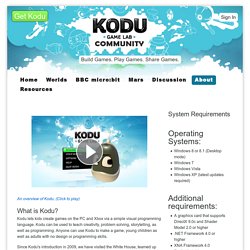
(Click to play) Kodu lets kids create games on the PC and Xbox via a simple visual programming language. Kodu can be used to teach creativity, problem solving, storytelling, as well as programming. Anyone can use Kodu to make a game, young children as well as adults with no design or programming skills. Since Kodu's introduction in 2009, we have visited the White House, teamed up with great groups like NCWIT and DigiGirlz, inspired academic research and been the subject of a book (Kodu for Kids).
Exploring Computational Thinking. Google is committed to promoting computational thinking throughout the K-12 curriculum to support student learning and expose everyone to this 21st century skill.
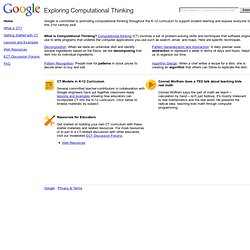
What is Computational Thinking? Computational thinking (CT) involves a set of problem-solving skills and techniques that software engineers use to write programs that underlie the computer applications you use such as search, email, and maps. Here are specific techniques. Decomposition: When we taste an unfamiliar dish and identify several ingredients based on the flavor, we are decomposing that dish into its individual ingredients. Pattern Recognition: People look for patterns in stock prices to decide when to buy and sell. CT Models in K-12 Curriculum Several committed teacher-contributors in collaboration with Google engineers have put together classroom-ready lessons and examples showing how educators can incorporate CT into the K-12 curriculum.
Resources for Educators Web Resources. Alice.org. New Tech Network. Eduteka. ISTE Computational Thinking. AgentSheets. ACM article - May 2012. By Alexander Repenning Communications of the ACM, Vol. 55 No. 5, Pages 38-40 10.1145/2160718.2160729 Comments Broadening participation by integrating game design into middle school curricula.
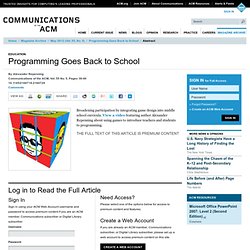
View a video featuring author Alexander Repenning about using games to introduce teachers and students to programming. The full text of this article is premium content Need Access? Please select one of the options below for access to premium content and features. Create a Web Account If you are already an ACM member, Communications subscriber, or Digital Library subscriber, please set up a web account to access premium content on this site. Join the ACM Become a member to take full advantage of ACM's outstanding computing information resources, networking opportunities, and other benefits.
Alexander Repenning. Computational Thinking - IAE-Pedia. Information Age Education (IAE) is an Oregon non-profit corporation created by David Moursund in July, 2007.

It works to improve the informal and formal education of people of all ages throughout the world. A number of people have contributed their time and expertise in developing the materials that are made available free in the various IAE publications. Click here to learn how you can help develop new IAE materials. Computers are incredibly fast, accurate, and stupid. Human beings are incredibly slow, inaccurate, and brilliant. Introduction The statement quoted above captures the essence of computational thinking. Here is a more recent description of computational thinking: Computational thinking is a way of solving problems, designing systems, and understanding human behavior that draws on concepts fundamental to computer science.
CSTA CT for K-12. CSTA Computational Thinking Task Force The purpose of the CSTA Computational Thinking Task Force is to inform and advise CSTA about current developments in computational thinking (CT) and to explore and disseminate teaching and learning resources related to CT.
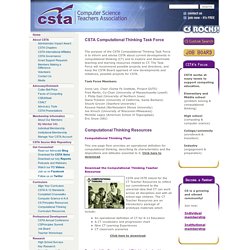
The Task Force will recommend possible projects and directions, and keep the CSTA Board apprised of new developments and initiatives, possible projects for CSTA. Task Force Members: Irene Lee, Chair (Santa Fe Institute, Project GUTS) Fred Martin, Co-Chair (University of Massachusetts Lowell) J. Philip East (University of Northern Iowa) Diana Franklin (University of California, Santa Barbara) Shuchi Grover (Stanford University) Roxana Hadad (Northeastern Illinois University) Joe Kmoch (University of Wisconsin-Milwaukee) Michelle Lagos (American School of Tegucigalpa) Eric Snow (SRI)
Learn to code.







